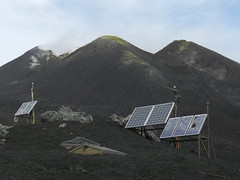
Every breath you take, every move you make ... I'll be watching you, a photo by etnaboris on Flickr.
One of the most important monitoring stations of the INGV-OE on Etna lies about 0.7 km southeast of the New Southeast Crater cone. The station is called Belvedere (the beautiful view, for obvious reasons), and is seen here in front of the huge new cone on 26 September 2012. The New Southeast Crater was the site of 25 lava fountaining episodes between January 2011 and April 2012. On 4 March 2012, lava flows passed just a few meters from the station, and it was feared that lava from the next episode would destroy it. However, lava did not take the same path again, and since 24 April 2012, there has been no further activity at the New Southeast Crater - except the formation of a new pit on the southwestern rim of the crater on 27 August 2012. I have come to call it "il pittino" (the little pit). A few further ash emissions occurred on 6-7 September from the "pittino", and since then it has been steaming vigorously but not shown any other activity. Gas emissions were conspicuous on 27 September 2012, but there is no further sign of activity - for the moment. In the meantime, all those instruments are faithfully recording every tiny blip, every move, every game the big volcano lady plays.



